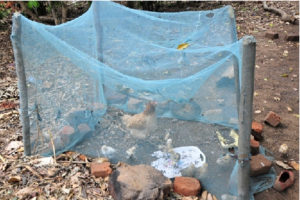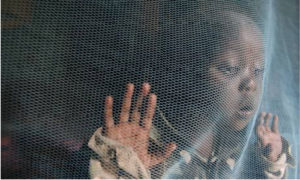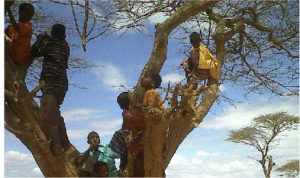Suggested Applications
NO MO can be applied effectively against a diverse array of the world’s most dangerous vector-borne diseases, both in combination with other interventions and alone. That makes it an important tool for disease reduction in poor communities around the world.
1. Complementing other protective measures such as insecticide-treated nets
 This strategy is particularly recommended for preventing malaria where:
This strategy is particularly recommended for preventing malaria where:
a. Local communities are reluctant to use bednets, resulting in low utilization
In certain cultures and climates, people are reluctant to the use insecticide treated bednets (ITNs). Even in Niger, where a national educational campaign was staged to raise ITN awareness, compliance among high-risk population groups remained well below the 80% utilization necessary to achieve the 50% reduction in morbidity claimed by advocates of ITN distribution.
 b. Resistance to pyrethroid insecticides used to treat bednets renders them ineffective.
b. Resistance to pyrethroid insecticides used to treat bednets renders them ineffective.
Reports of kdr (knock-down resistance) and other pyrethroid-resistance mechanisms continue to mount throughout the world. Recent reports suggest that selection is now occurring in areas where insecticide-treated bednets represent the only substantial selective force (Niger) and in some areas efficacy of ITNs is beginning to be compromised (Benin).
c. Exophilic, early-feeding vectors cause a substantial portion of malaria transmission to occur outside the home or before people retire under their bednets.
Anopheles darlingi, the principal vector for malaria in Latin America (85% of all cases), feeds primarily in the early evening hours when many people with bednets may not be protected. Numerous other exophagic vectors exist throughout the world. In addition, some places in Africa with historically endophagic vectors have begun to report evidence of selection for behavioral changes in mosquitoes shifting biting pressure to earlier hours of the evening. Such trends will only increase as selective pressure from increasing ITN distribution mounts.
 Even in areas where bednet utilization is good and bednets are effective, the complementary use of repellents may enhance the impact of ITNs. Since utilization rates are never perfect, repellents could protect those who don’t own a bednet or refuse to sleep under one, but are not averse to applying repellents to their skin. Repellents would also protect compliant bednet users before they retire under their nets and in situations where their nets become damaged and allow mosquito entry. Repellents would amplify the killing effect of ITNs by keeping exophagic, early-evening biters in a host-seeking mode, thus increasing the odds that more of them come into contact with the toxins used to treat bednets. In the absence of repellents, this subset of the mosquito population could transmit infections, acquire blood meals and escape contact with lethal insecticides.
Even in areas where bednet utilization is good and bednets are effective, the complementary use of repellents may enhance the impact of ITNs. Since utilization rates are never perfect, repellents could protect those who don’t own a bednet or refuse to sleep under one, but are not averse to applying repellents to their skin. Repellents would also protect compliant bednet users before they retire under their nets and in situations where their nets become damaged and allow mosquito entry. Repellents would amplify the killing effect of ITNs by keeping exophagic, early-evening biters in a host-seeking mode, thus increasing the odds that more of them come into contact with the toxins used to treat bednets. In the absence of repellents, this subset of the mosquito population could transmit infections, acquire blood meals and escape contact with lethal insecticides.
Under the best circumstances (>80% utilization, highly endophagic vectors), reductions in malarial morbidity from ITN use alone are limited to about 50%. While these benefits are substantial, it may be possible to exploit a synergistic relationship with personal repellents in order to enhance ITN’s benefits further.
2. Repellent-only applications against vector-borne infections
This strategy is recommended against vector-borne diseases for which vector control is difficult, expensive or ineffective. The two diseases that best exemplify this situation are leishmaniasis and dengue fever.
Leishmaniasis is transmitted by phlebotomine sandflies in the family Psychodidae. Lutzomyia spp. transmit infections in the New World, while Phlebotomus and Sergentomyia spp. predominate in the Old World. The presence of animal reservoirs of infection complicates control of this disease, and the larval habitats of sandflies are often cryptic and inaccessible, thus rendering source reduction impractical. Additionally, early evening biting activity limits the effectiveness of bednet-only interventions.
 Dengue fever is transmitted by Aedes aegypti and A. albopictus mosquitoes. They breed mostly in containers and bite during the day. Interventions against outbreaks of Dengue Fever are notoriously difficult because the simple measures like bednets employed against other vector-borne diseases like malaria have no effect on the day-biting vectors of dengue. Other measures such as indoor fumigation or ultra-low volume (ULV) spraying by ground or air have often proved ineffective in trials due to the complexity of the urban landscapes in which dengue vectors thrive. Environmental sanitation of discarded automobile tires and artificial containers, while helpful, does not appear to have the capacity to prevent or interdict epidemics.
Dengue fever is transmitted by Aedes aegypti and A. albopictus mosquitoes. They breed mostly in containers and bite during the day. Interventions against outbreaks of Dengue Fever are notoriously difficult because the simple measures like bednets employed against other vector-borne diseases like malaria have no effect on the day-biting vectors of dengue. Other measures such as indoor fumigation or ultra-low volume (ULV) spraying by ground or air have often proved ineffective in trials due to the complexity of the urban landscapes in which dengue vectors thrive. Environmental sanitation of discarded automobile tires and artificial containers, while helpful, does not appear to have the capacity to prevent or interdict epidemics.
As mentioned, a repellent-only strategy may also be practical against malaria in situations where the principal local vector has a strong tendency for early evening, outdoor biting, or where access to, or compliance with, bednets is problematic. In such situations, complete distribution and high compliance would be necessary to maximize the positive effects of the repellent. This approach may be particularly effective in areas where the local vectors have a significant tendency to feed on non-human hosts, a behavior which would allow diversion of biting to animals and even selection for animal-biting tendencies.
3. Repellent-only applications against nuisance mosquitos
Many communities face debilitating attacks from non-vector, nuisance insects. Numerous species of mosquitoes and biting midges exert enormous biting pressures on people living near their breeding sites. While the morbidity and mortality resulting from these assaults may be low, nuisance biters can severely degrade the quality of life and productivity of communities they affect. Repellents would greatly ease these burdens as well as protecting users against any disease vectors that may also affect them.
As mentioned, where aggressive nuisance insects such as Culex and Mansonia spp. coexist with disease vectors, their presence may drive higher utilization rates of repellent than would occur if only night-time, anopheline vectors were found. This effect would be most powerful where nuisance mosquitoes begin biting near sunset, or shortly after nightfall, prompting residents to apply repellent for relief. This single application of repellent could then provide protection against disease vectors later, when biting peaks.
